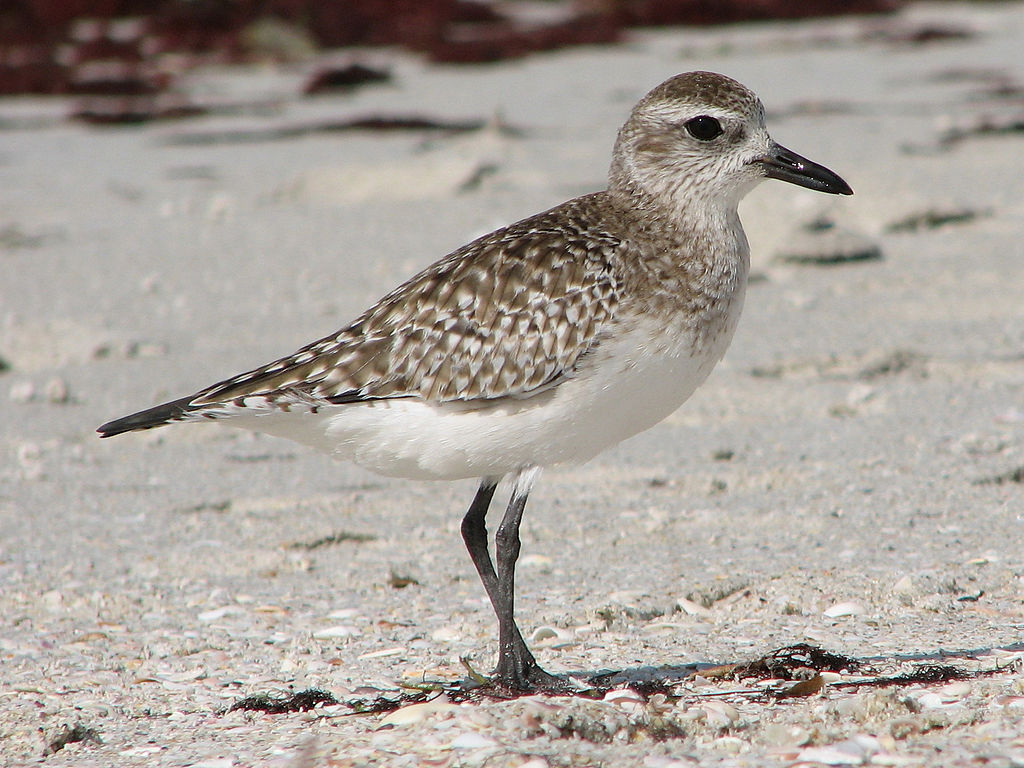Plovers - in Belize
Black-Billed Plover
Black Billed Plover - Fairly large shorebird with a short, stout bill. In breeding season, shows striking black face and belly with bold black-and-white checkering on upperparts. In nonbreeding season, more uniformly drab gray with white belly. Feeds on beaches and mudflats by walking or running, stopping, and pecking at the surface. Most commonly seen in coastal areas during winter. Breeds on arctic tundra.
BELIZE HABITAT - Coastal beaches, mudflats, shrimp farms. Where can I find this bird in Belize? Uncommon to locally common winter visitor on the cayes and mainland coast, mid-July to early June; a few remaining through summer (or over-lapping spring and autumn migrants). |
American Golden Plover
American Golden Plover - Slender, long-winged plover usually found in relatively dry habitats. Breeds in Arctic tundra. During migration, prefers sod fields, dry mudflats, and pastures; often in small flocks. Breeding plumage shows black belly and face, white neck, and dark back and crown spangled with gold. Undertail coverts are entirely black on breeding birds, but beware molting birds can be mottled with white. Nonbreeding and juvenile much drabber; grayish overall with distinct white eyebrow and small pale spots on upperparts. Most easily confused with Black-bellied and Pacific Golden-Plover. American often has more golden tones with a thinner bill than Black-bellied. American is slightly longer-winged and shorter-legged than Pacific Golden-Plover, but difficult to judge. Juvenile American usually duller than Pacific. Average habitat preferences are important to note (Pacific Golden and Black-bellied more regular on beaches and mudflats), but much overlap. Range is also important. Note voice; a plaintive "pleedoo" call.
BELIZE HABITAT - Newly planted rice fields, short-grass meadows, savannas. Where can I find this bird in Belize? Uncommon and local spring migrant, early March to late May; unrecorded in autumn. Most records are from Blue Creek rice fields in Orange Walk. |
Killdeer
Killdeer - Widespread shorebird, often nests near human development and far from water: parking lots, school roofs, road edges and other spots with bare gravel. Two black bands across breast set it apart from other plovers. Vocalizes frequently, giving loud, whinnying "kill-deer" call.
BELIZE HABITAT - Many open short-grass habitats, including lawns, agricultural fields, and pastureland. Where can I find this bird in Belize? Fairly common winter visitor, early October to early April, occasionally later. |
Snowy Plover
Snowy Plover - Small, pale plover with broken black collar. In breeding plumage, black ear patch distinctive. Thin black bill separates from other small plovers at all times of year. Long grayish legs. Found on coastal and inland sandy beaches; can be seen singly or in small loose flocks. Quickly darts around searching for invertebrates in the sand.
BELIZE HABITAT - Sandflats, beaches, drying shrimp farm ponds. Where can I find this bird in Belize? Winter visitor, few documented records. |
Collard Plover
Collard Plover - Uncommon, petite plover of beaches, coastal lagoons, lakeshores, gravel bars, and sandbars along rivers. Note slender black bill, brightly patterned head, narrow black breast band, and long pinkish legs. Despite the name, does not have white collar around back of neck like most small plovers. Typically found in pairs or as single birds; not in flocks like many other small plovers. At high tide they often roost with other plovers such as Wilson’s and Semipalmated plovers.
BELIZE HABITAT - Shrimp farm dikes, sandlfats and mudflats. Where can I find this bird in Belize? Very uncommon migrant, winter visitor, and perhaps local resident on north cayes and mainland coast. Nested at Nova Shrimp Farm in Belize in 1999. |
Wilson's Plover
Wilson's Plover - Large black bill is diagnostic. Slightly larger than similar plovers, with large blocky head. Breeding plumage shows thick black band across breast, white forehead, and bolder face pattern; nonbreeding birds show less contrast. Legs dull pinkish. Found on sandy beaches, usually singly but sometimes in small loose flocks. Medium-brown upperparts similar but slightly paler than Semipalmated Plover, notably darker than Snowy or Piping.
BELIZE HABITAT - Sandflats and mudflats, shrimp farm dikes. Where can I find this bird in Belize? Uncommon winter visitor and local resident on inner cayes and mainland coast south to north Toledo, occasionally to Punta Gorda; nests on Ambergris Caye and perhaps a few other cayes, and locally along north mainland coast. |
Semi-Palmated Plover
Semi-Palmated Plover - Small shorebird; smaller than Killdeer. Brown above and white below, with a single black breast band. Short bill with orange base and black tip. Often appears stocky with no neck. Feeds on mudflats and beaches, often mixed with other shorebirds. Even when in a flock, individuals are typically spread out rather than remaining in a tight unit.
BELIZE HABITAT - Sandflats and mudflats, shrimp farms; occasionally rice fields. Where can I find this bird in Belize? Fairly common to locally common migrant and less common winter visitor on cayes and mainland coast, mid July to late May. A few occasionally remain through summer. During migration, found in small to moderate numbers at a few inland localities (i.e. Blue Creek rice fields, Orange Walk Crooked Tree Belize). |








